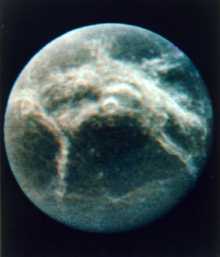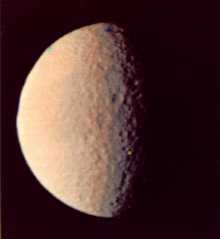This is an image of Dione.
Click on image for full size
NASA/JPL
Dione
Dione was discovered by G. Cassini in 1684. Dione is the 7th farthest moon from Saturn, with a standoff distance of 377,400 km. It is a small
icy moon, lightly cratered, with wispy white streaks across the
surface. Dione is about as wide as the Oregon coast is long, a width of 1120 km, or 750 miles. In appearance, it looks very much like
Rhea,
Enceladus, and
Tethys.
You might also be interested in:

Icy moons are large or small moons which are mostly made of ice. These moons are unlike the earth's moon, which is made of silicate rock. Perfect examples of icy moons are 3 of the Galilean satellites,
...more
The surface of Dione does not have many craters. Instead it has wispy white streaks similar to those found on Rhea extending for many kilometers over the entire surface. These two things indicate that
...more
Rhea was discovered by G. Cassini in 1672. Rhea is the 5th farthest moon from Saturn. It is one of the icy moons, similar to the Galilean satellites. Rhea is about as wide as the state of California is
...more
Enceladus is a moon of Saturn. It is Saturn's sixth largest moon. Saturn has // Call the moon count function defined in the document head print_moon_count('saturn'); moons. Enceladus was discovered in
...more
Tethys was discovered by G. Cassini in 1684. Tethys is the 8th closest moon to Saturn, with a standoff distance of 294,660 km. It is one of the icy moons, similar to the Galilean satellites. Tethys is
...more
This is an image of the Earth's moon, shown in the lower left, with the much smaller icy moons of Saturn. The moons in order, starting from the top left are: Mimas, Enceladus, Tethys, Dione, Rhea, and
...more
The gas giant planet Saturn has a large group of // Call the moon count function defined in the document head print_moon_count('saturn'); moons. It also has the largest, most complex, and best-known ring
...more
Dione was discovered by G. Cassini in 1684. Dione is the 7th farthest moon from Saturn, with a standoff distance of 377,400 km. It is a small icy moon, lightly cratered, with wispy white streaks across
...more












